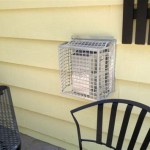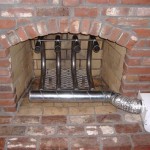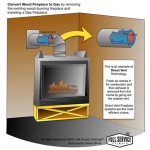Mounting a TV Over a Fireplace Niche: Considerations and Best Practices
Mounting a television above a fireplace niche presents a unique set of challenges and opportunities for homeowners seeking to optimize their living space. While it can create a visually appealing focal point, careful planning and execution are essential to ensure both the longevity of the television and the safety of the installation. This article will explore the key factors to consider when mounting a TV over a fireplace niche, including thermal considerations, structural integrity, viewing angles, and cable management.
Understanding Thermal Concerns
One of the primary concerns with mounting a television above a fireplace is the potential for heat damage. Fireplaces, whether wood-burning, gas, or electric, generate significant heat that can rise and negatively impact the sensitive electronics within a television. Elevated temperatures can lead to a shortened lifespan, color discoloration, and even permanent damage to the screen or internal components. The extent of the risk depends on several variables, including the type of fireplace, the frequency and duration of use, the presence of a mantel, and the distance between the fireplace and the television.
Wood-burning fireplaces typically produce the highest temperatures, posing the greatest risk to a mounted television. Gas fireplaces generally generate less heat, but the radiant heat can still be significant. Electric fireplaces often offer adjustable heat settings, providing some control over the thermal environment. However, even with electric fireplaces, prolonged use at higher settings can contribute to increased ambient temperature around the television.
A mantel can act as a shield, deflecting rising heat away from the television. The size and shape of the mantel significantly influence its effectiveness. A deeper mantel provides greater protection, while a shallower mantel offers minimal heat deflection. The distance between the top of the fireplace and the bottom of the television is also crucial. A greater distance allows for better heat dissipation before it reaches the television. Experts recommend a minimum distance of 12 inches, but more may be necessary depending on the fireplace type and usage.
To mitigate thermal risks, consider the following strategies: use a temperature sensor placed near the television to monitor heat levels during fireplace use; employ a mantel with sufficient depth to deflect heat effectively; opt for an electric fireplace with adjustable heat settings or a fireplace with a sealed combustion system; and limit fireplace use during periods when the television is in operation. Furthermore, ensuring adequate ventilation around the television is essential. Avoid enclosing the television in a tight-fitting cabinet or alcove, as this can trap heat and exacerbate thermal issues.
Assessing Structural Integrity and Mounting Options
The structural integrity of the wall above the fireplace is a critical factor to consider before mounting a television. The wall must be capable of supporting the weight of the television and the mounting bracket. Identifying the wall studs is essential for securely attaching the mounting bracket. Wall studs are typically spaced 16 or 24 inches apart and provide a solid anchor for screws or bolts. Using a stud finder can simplify the process of locating studs behind drywall or other wall coverings.
In situations where the wall above the fireplace is constructed of brick, concrete, or stone, specialized mounting hardware and techniques are required. These materials are significantly denser and stronger than drywall, necessitating the use of masonry anchors and drill bits designed for these surfaces. It is often advisable to consult with a professional installer experienced in working with masonry walls to ensure a secure and stable installation.
Several types of television mounting brackets are available, each offering different features and functionalities. Fixed mounts provide a simple and low-profile solution, holding the television close to the wall. Tilting mounts allow the television to be angled downward, improving the viewing angle from certain positions. Full-motion mounts offer the greatest flexibility, allowing the television to be extended, swiveled, and tilted for optimal viewing from various locations in the room. The choice of mounting bracket depends on the size and weight of the television, the desired viewing angle, and the aesthetic preferences of the homeowner.
When selecting a mounting bracket, it is imperative to ensure that it is compatible with the television's VESA (Video Electronics Standards Association) mounting pattern. The VESA pattern refers to the standardized hole pattern on the back of the television that is used to attach the mounting bracket. Incorrectly matching the VESA pattern can result in an unstable or incompatible installation. Always consult the television's user manual or manufacturer's website to determine the correct VESA pattern before purchasing a mounting bracket.
Optimizing Viewing Angles and Ergonomics
Mounting a television above a fireplace niche often results in a higher viewing angle than is ergonomically ideal. Prolonged viewing at an upward angle can lead to neck strain, eye fatigue, and discomfort. To mitigate these issues, careful consideration should be given to the height at which the television is mounted. The goal is to position the television so that the viewer's eyes are at approximately the same level as the center of the screen when seated in their typical viewing position.
The optimal viewing distance is also an important factor to consider. As a general guideline, the viewing distance should be approximately 1.5 to 2.5 times the diagonal screen size of the television. For example, a 55-inch television should ideally be viewed from a distance of 82.5 to 137.5 inches. Adjusting the seating arrangement to achieve the optimal viewing distance can significantly improve the viewing experience and reduce eye strain.
Using a tilting mount can help to improve the viewing angle by allowing the television to be angled downward. This is particularly beneficial in situations where the television is mounted relatively high above the fireplace. The amount of tilt required depends on the specific mounting height and the viewing distance. Experimenting with different tilt angles can help to find the optimal position for comfortable viewing.
Another strategy for improving ergonomics is to consider the size of the television. A smaller television may be more comfortable to view from a closer distance, while a larger television may be better suited for a larger room with a greater viewing distance. Selecting the appropriate television size can significantly enhance the viewing experience and reduce eye strain.
Managing Cables for a Clean Aesthetic
Effective cable management is essential for achieving a clean and aesthetically pleasing installation. Hiding the cables that connect the television to power, audio, and video sources can significantly improve the overall appearance of the living space. Several options are available for concealing cables, ranging from simple solutions to more elaborate installations.
One common approach is to use cable concealment kits, which typically include plastic channels or tubes that can be mounted to the wall to hide the cables. These kits are available in various sizes and colors to match the existing décor. The cables are routed through the channels, providing a neat and organized appearance. Cable concealment kits are relatively easy to install and can be a cost-effective solution for hiding cables.
Another option is to run the cables through the wall. This involves drilling holes in the wall behind the television and near the floor, and then routing the cables through the wall cavity. This method provides a completely hidden cable solution, but it requires more effort and expertise to install. Furthermore, it is essential to ensure that any in-wall cabling complies with local building codes and safety regulations.
For a more sophisticated cable management solution, consider using a power bridge or a recessed outlet box. A power bridge is a device that allows you to safely run power and low-voltage cables through the wall without violating electrical codes. A recessed outlet box provides a clean and flush-mounted solution for connecting the television to power and other sources. These options require more advanced installation skills, but they offer a professional and seamless appearance.
Regardless of the cable management method chosen, it is crucial to label all cables clearly before hiding them. This will make it easier to identify and troubleshoot cables in the future. Using cable ties or Velcro straps to bundle the cables together can also help to keep them organized and prevent tangling. Taking the time to plan and execute a proper cable management strategy will significantly enhance the overall aesthetic of the installation and make it easier to maintain the system over time. Careful consideration of these factors will contribute to a successful and enjoyable home entertainment experience.

My Story How I Eliminated Tv Niche Above The Fireplace Over

Condo Blues How To Mount A Big Flat Screen Tv In Small Niche

My Story How I Eliminated Tv Niche Above The Fireplace Avs Home Theater Discussions And Reviews Room Design Nook

Tv Niche Nook Decor

Condo Blues How To Mount A Big Flat Screen Tv In Small Niche

My Story How I Eliminated Tv Niche Above The Fireplace Page 3 Avs Forum

My Story How I Eliminated Tv Niche Above The Fireplace Small Wall Mounted

Tv Problem Niche Nook Makeover

Tackling My First Mantelmount Mm720 Pull Down Tv Mount Install

Tackling My First Mantelmount Mm720 Pull Down Tv Mount Install








